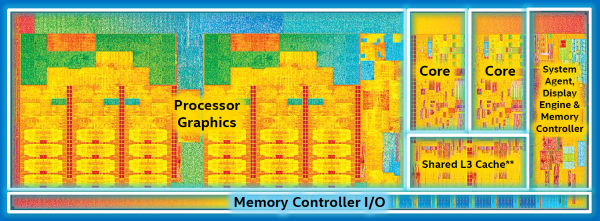Where Are Intel's Desktop Broadwell CPUs?
Intel's Skylake CPUs have now been released, ushering in a new generation of computer hardware. We have seen dozens of new motherboards, the latest 100 series chipsets, the growth of DDR4, but the one thing we haven't seen much of is Skylake's desktop predecessor, Broadwell. Given the turn of events, many have speculated that Broadwell may never actually come to the desktop market, but Intel has informed us otherwise.
The Long Wait For Broadwell
The release of Intel's Broadwell CPUs have been anticipated for a long time now. Broadwell's predecessor, Haswell, originally shipped back in 2013, right on schedule to take over the market from Intel's Ivy Bridge chips. Everyone expected to see Haswell meet its end in a timely fashion as well, replaced by Broadwell some time in 2014, but instead we received a refreshed Haswell lineup headed by the Devil's Canyon series of CPUs.
In August 2014, we got our first glimpse at what Broadwell might be with the introduction of Intel's Core M on the latest 14nm fab. New mobile processors would begin to show up over the months, but nothing for the LGA 1150 platform.
Not long ago, it looked like the wait might be over when Intel sent samples of the desktop Broadwell i7-5775C and i5-5675C to us. We finally got a look at what Broadwell is capable of -- but the market release never came.
Then, suddenly, Intel released Skylake. Intel's roadmaps pointed to the release of Skylake in 2015, but because Broadwell was still missing in action from all major retailers, we didn't expect Skylake to come out on time. Needless to say, this raised a lot of questions.
Broadwell: Lost On Monkey Island
Intel didn't tell us why Broadwell is so late, but we can speculate about the problem. One theory blames the move to a 14nm fab.
The fabs used by Intel are among the fastest in the world. Intel was the first company to make the move to the 22nm process, while everyone else was stuck at 28nm or larger processes.
Get Tom's Hardware's best news and in-depth reviews, straight to your inbox.
Intel was, again, the first to move to 14nm, but it seems this transition has been anything but smooth. The first 14nm chips produced by Intel were the Core M products, followed by other small mobile CPUs. All of these processors were relatively small in size, and Intel didn't release larger quad-core SKUs on the 14nm process for desktop or mobile products until much later. These factors point to problems with the early 14nm process, preventing Intel from releasing Broadwell in force.
Now that Intel is mass producing larger quad-core 14nm SKUs and releasing them on the market, it would appear Intel has overcome the early difficulties it faced with its 14nm process, but Broadwell faces another challenge: Skylake.
Although Skylake has been released onto the market, Intel is facing extreme difficulties filling the orders. Retailers frequently sell out, and few users have been able to get ahold of the new processors. As both Skylake and Broadwell use the same 14nm fab, and Intel can't produce Skylake fast enough to meet the demand, it is likely that Intel will hold off releasing Broadwell desktop SKUs until it has an adequate supply of Skylake parts already made up.
Too Little Too Late?
Broadwell will escape and find its way to market, but how long will it take? And who will care?
Although Broadwell still isn't readily available yet, Intel did tell us that Broadwell CPUs are coming to market, but we may be waiting a while before they do.
At this point, it is surprising that Intel will be releasing Skylake's predecessor -- after Skylake chips enter the market -- but at least it will give users on the LGA 1150 platform a few new upgrade options.
Don't expect a lot from Broadwell though. Intel told us that, currently, it only has plans for two Broadwell SKUs, the i7-5775C and i5-5675C. This is more than a little surprising, but in a way it makes sense. Skylake is already here, and anyone building a new system will most likely want to use the latest platform and the most advanced hardware. Broadwell will probably only be appealing to users who already own an LGA 1150 system and want to upgrade without needing to buy a full system. From this perspective, releasing just two relatively high-end SKUs makes some sense.
Now that Intel appears to have resolved its manufacturing problems, the only thing holding back Broadwell is the high demand for Skylake, and the speed with which Intel can produce 14nm parts. Broadwell will still succeed Haswell on the LGA 1150 platform, but the CPU is essentially lost in time. Most enthusiasts have moved to greener pastures, leaving Broadwell behind, and only those few users upgrading lower-end Haswell parts will ever make use of it. The i7-5775c was designed to be, at least for a time, Intel's flagship consumer product, but instead it will be but a small footnote in Intel's CPU history.
Follow Michael Justin Allen Sexton @LordLao74. Follow us @tomshardware, on Facebook and on Google+.
-
TechyInAZ That's a sham. I always wondered why Broadwell was so late.Reply
Intel could of gone to an 18nm process if possible for broadwell. If that would of allowed broadwell to get to market quickly enough. -
synphul It makes sense. Intel did have problems smoothing out the 14nm process which is why broadwell and skylake were so delayed to begin with, leaving haswell refresh and devil's canyon as gap fillers in the meantime. Intel said a good while back they wanted to skip broadwell all together and was only going ahead with the desktop cpu's because people complained they wanted them. Why I'm not sure, aside from the smaller process and slightly better igpu, broadwell has/had no major performance gains.Reply
It's just my opinion, but that's every 'tick' cycle. You have a tock cycle like sandy bridge with performance improvements followed by ivy which offered little to nothing over sandy bridge other than it was the newest chip for those who upgraded after sandy bridge came out. It certainly wasn't any type of 'upgrade' for sandy owners and the next chips following would use a different socket anyway. Same with haswell and broadwell, very few if any will put out money for a side grade from haswell to broadwell and those are the only two compatible with lga 1150. The next performance increase (even if it's the roughly 10% seen with most generation upgrades) is skylake, again on a new socket.
There's no point in upgrading 1 generation (2nd to 3rd, 4th to 5th) just to retain the same motherboard. Intel knew aside from the mobile market which would benefit from lower power consumption and improved igpu's, broadwell would be a fizzle on the desktop and it's no wonder they're dragging their feet. Broadwell was dubious at best to begin with and that's if it had released on time. Given the delay, may as well forget it and move on to skylake. It's not as if anyone is going to suffer the loss of broadwell other than to say they have a 'newer gen' cpu, it's a typical 'tick' cycle.
Lowered frequency, improved efficiency on a smaller die making the performance equal to the generation before it. Being on the same socket/platform as 4th gen haswell/d.c. it brings literally nothing to the table anyway. I think it pretty much embraces what the author said - "And who will care?"
Even with the relatively major changes with skylake, ddr4, increased pcie lanes (upped by a whole 4 lanes), thunderbolt etc (significant compared to previous ddr3 based platforms like 1155/1150) there's not a whole lot compelling people with 3rd and 4th gen cpu's to run right out and upgrade. More or less for those running 2nd gen or older who held out for the couple of additional perks 1151 brings with it. Broadwell is a one horse town hardly worth plotting on the map and I don't think it will make a bit of difference if it ever surfaces or not. -
gilbadon All I heard was the worlds smallest violin playing while Intel grabbed their bulldozer to swoop up all our money.Reply -
MarkW I7-6700K still is not available in the US.Reply
I5-6400 is slated for an October 8th arrival one place I saw.
i5-6600K has been pretty much in stock at Amazon for about 6 weeks.
But Intel is clearly still having problems with larger chips, and we are not yet even seeing the smaller I3 and other Skylake CPU's. -
f-14 ReplyI7-6700K still is not available in the US.
http://www.microcenter.com/product/451883/Core_i7-6700K_40GHz_LGA_1151_Boxed_Processor
I5-6400 is slated for an October 8th arrival one place I saw.
i5-6600K has been pretty much in stock at Amazon for about 6 weeks.
But Intel is clearly still having problems with larger chips, and we are not yet even seeing the smaller I3 and other Skylake CPU's.
http://www.microcenter.com/product/451885/Core_i5-6600K_35GHz_1151_Boxed_Processor
mark be nimble, mark be quick, mark tripped and that's why he did not get the 6700K
i will be putting it into a system tomorrow after buying it labor day to try it out.
ASUS Z170 Maximus VIII LGA 1151 mATX Intel Motherboard
http://www.microcenter.com/product/452549/Z170_Maximus_VIII_LGA_1151_mATX_Intel_Motherboard -
nutjob2 Intel seems to be trying to save money, it seems. Rather than throw money at process shrinks and keeping up with Moore's law, they seem to be in a bit of a panic with their mobile CPU fail. In traditional Intel fashion they're dumping money into mobile, giving away product, but it's a deep hole they've found themselves in.Reply -
IInuyasha74 Reply16609151 said:Intel seems to be trying to save money, it seems. Rather than throw money at process shrinks and keeping up with Moore's law, they seem to be in a bit of a panic with their mobile CPU fail. In traditional Intel fashion they're dumping money into mobile, giving away product, but it's a deep hole they've found themselves in.
Well, it is expected to a point. These fabs cost billions of dollars to build, and the companies and companies like Intel are inventing the technology that makes a new fab possible when they upgrade. 22nm seemingly came out without a problem, but older fabs have proven more difficult to develop. So there are a few reasons why it is taking Intel a while to get all the bugs worked out, and if they do have it working fine now, they can't really build a new fab to help with it. They have the billions of dollars to throw at the problem, but it takes a few years to build, and by the time it is finished we will be at 7nm or something similar. -
QSV ReplyJust wait for Skylake desktop chips, skip Broadwell all together?
I wish it was that simple.
If youre a pure gamer I would recommend an i7-5775C over an i7-6700k any time, because that eDRAM helps quite a lot and makes the Broadwell faster in games, even though it has 500 MHz less. Yes, even with discrete graphics.
But the best thing of course would be a Skylake with eDRAM, replacing the i7-5775C. But there isnt one and last I heard they are not planning to release one.
If the i7-5775C was OC-able better than it is (youre lucky to reach 4.2 GHz), I would buy one now for sure.

